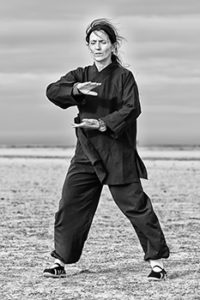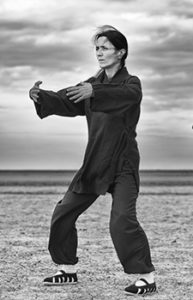 According to Swedish psychologist K. Anders Erickson, sometimes referred to as the “expert on experts,” those who are the best at what they do are attentive to feedback. Without feedback, how do we know how and when we improve? Many sports have measurable criteria for detecting improvements (e.g., times and distances that are objectively measured), and these can be used as one form of feedback that can help athletes improve. But how do we get the feedback to improve in more personal, and less measurable, endeavors like Taijiquan (太極拳)?
According to Swedish psychologist K. Anders Erickson, sometimes referred to as the “expert on experts,” those who are the best at what they do are attentive to feedback. Without feedback, how do we know how and when we improve? Many sports have measurable criteria for detecting improvements (e.g., times and distances that are objectively measured), and these can be used as one form of feedback that can help athletes improve. But how do we get the feedback to improve in more personal, and less measurable, endeavors like Taijiquan (太極拳)?
By maximizing opportunities to gain feedback, elite performers in their fields increase their chances to learn from that feedback. Taijiquan practice begins with relying on the instructions of one’s teacher(s), but the goal is to gain awareness of our bodies such that one’s body becomes a teacher, one’s own body provides feedback. Self-awareness is one reason why Taijiquan is called an “internal” martial art, and the following are examples of levels of awareness.
NOVICES:
Novice practitioners frequently begin learning in a way that is similar to dancers, by learning a choreographed sequence of postures. Some schools require students to meditate prior to the forms instruction in order to clear the students’ minds and reduce their mental distractions. This increases the potential for paying attention to what their bodies are indicating during their physical practice.
Many schools use the concept of feeling qi (氣) or energy flow in the body. This is something that is difficult to visually detect in the teacher, and something that must be felt in oneself. While this practice does direct students to pay attention to their bodies, unfortunately, there are potential pitfalls to sensing qi, especially for novices.
Our minds have a tendency to deceive us, allowing us to sense what we expect or desire to feel. It is difficult to differentiate between what is real and what merely exists due to expectation or desire. Numerous examples of this problem can be found in scientific studies in psychology, where it is extremely difficult to design rigorous and relevant controls.
One example of this phenomenon can be seen in a study that tested if meditation helps reduce stress. The researchers (Creswell et al., 2014, Psychoneuroendocrinology, 4: pp.1-12) compared stress levels of subjects who, after their meditation, took a standard task assessment (the Trier Stress Protocol), designed to be difficult enough to induce high stress. These were compared to similar subjects who took the same test but without the pre-test meditation.
The study design was superior to most similar research in that selection bias was controlled for, as well as having the controls undertaking similar learning processes to the group being taught meditation, except without the meditation component. They also had an objective control for the typical subjective questionnaire, by drawing a blood sample and measuring cortisol levels (a hormone that is elevated in stressful situations).
The results were surprising. The subjective questionnaire results showed that the meditating subjects had a perception of significantly reduced levels of stress after the stressful task that followed meditation, when compared to the control participants, as was expected. But their cortisol levels were actually significantly higher than in the controls! While the mediators FELT that they were less stressed, their levels of stress were actually higher!
Until a practitioner can distinguish actual sensations of qi circulation from imaginary ones, relying on subjective feelings of qi is probably not useful. However, once a practitioner can reliably perceive their qi, then increases or decreases would provide feedback into the quality of their practice.
BEGINNERS:
While self-assessments of qi levels are unreliable, there are numerous physical principles that are easy to observe and can be used for feedback. Correct understanding and application of physical principles will aid in increasing the feelings of qi circulation; but since the physical principles are easier to detect, they may be better for feedback in beginners than the potentially unreliable feelings of qi.
Various physical and postural principles are taught while students are learning solo forms, and physical corrections to postures are common long after students complete a form. The feedback from a teacher is valuable, but if students learn and understand the principles, then they can self-correct many errors by checking themselves in a mirror. These physical/postural principles are typically noticeable to students, if they know what to look for.
UNDERSTANDING ONESELF:
 The individual physical principles that are learned in Taijiquan cannot all be focused on simultaneously. At best we can focus on one or two at a time (see my earlier article on multitasking), switching from one to another during different practice periods.
The individual physical principles that are learned in Taijiquan cannot all be focused on simultaneously. At best we can focus on one or two at a time (see my earlier article on multitasking), switching from one to another during different practice periods.
Knowing Without feedback, how do we know how and when we improve? Many sports have measurable criteria for detecting improvements , and these can be used as one form of feedback that can help athletes improve. oneself involves synthesizing the various individual components into one whole. It is like the difference between a spider making individual threads of a web, and the completed web where the spider can sit in the center and be able to sense the entire web simultaneously. Understanding ourselves is the stage where we achieve wholeness or oneness, rather than having to think about individual pieces.
At this stage, physical corrections may become too subtle to detect visually, so another method of receiving feedback becomes necessary. For those who can now reliably sense their qi flow, this can be used for feedback. Like an undisturbed spider web, one should feel correct and be comfortably aligned. When the “web” is disturbed by errors, then ones attention should be directed to the problem area.
Since this stage relies on self-evaluation, one’s ego can interfere with making objective evaluations of one’s abilities. It is human nature to think we are better than we really are. Often, postural habits feel comfortable, but these could contain errors that one may not be aware of. “Comfortable” does not necessarily mean correct, and one must be objective in evaluating whether or not one is actually incorporating proper Taijiquan postural and energetic principles. Care should be taken since incorrect habits can often feel more comfortable than correct practice.
To obtain more objective feedback, one can focus on interactive work, where a training partner or opponent provides challenges to ones posture and movement.
Pages: 1 2